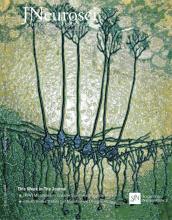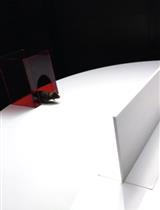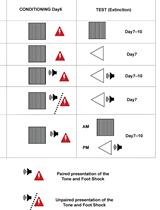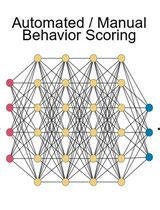- EN - English
- CN - 中文
Olfactory Cued Learning Paradigm
嗅觉暗示学习范例
(*contributed equally to this work) 发布: 2017年05月05日第7卷第9期 DOI: 10.21769/BioProtoc.2251 浏览次数: 8910
评审: Xi FengAdler R. DillmanManuel Sarmiento
Abstract
Sensory stimulation leads to structural changes within the CNS (Central Nervous System), thus providing the fundamental mechanism for learning and memory. The olfactory circuit offers a unique model for studying experience-dependent plasticity, partly due to a continuous supply of integrating adult born neurons. Our lab has recently implemented an olfactory cued learning paradigm in which specific odor pairs are coupled to either a reward or punishment to study downstream circuit changes. The following protocol outlines the basic set up for our learning paradigm. Here, we describe the equipment setup, programming of software, and method of behavioral training.
Keywords: Olfactory (嗅觉)Background
The adult brain features ongoing experience-dependent structural changes. Within the rodent olfactory bulb (OB) where odor information is first processed, a continuous supply of adult born interneurons (granule cells) either integrates into the olfactory circuitry or undergoes apoptosis (Petreanu and Alvarez-Buylla, 2002; Carleton et al., 2003; Lledo et al., 2006; Sakamoto et al., 2014). This choice between survival or death is greatly influenced by sensory stimulus and olfactory cued learning (Rochefort et al., 2002; Alonso et al., 2006). Moreover, younger granule cells also undergo experience-dependent synaptic changes within a critical time window (Yamaguchi and Mori, 2005). To examine how sensory experience affects synaptic plasticity in OB circuits, our lab has successfully implemented a Go/No-Go olfactory cued learning task (Huang et al., 2016; Quast et al., 2016). Mice are trained to associate a ‘Go Odor’ with a water reward and a separate ‘No-Go Odor’ with a punishment (trial timeout) (Figure 1). Upon completion of training, mice will be able to distinguish the two odors by performing the associated task with greater than 85% accuracy (Supplemental Video 1). 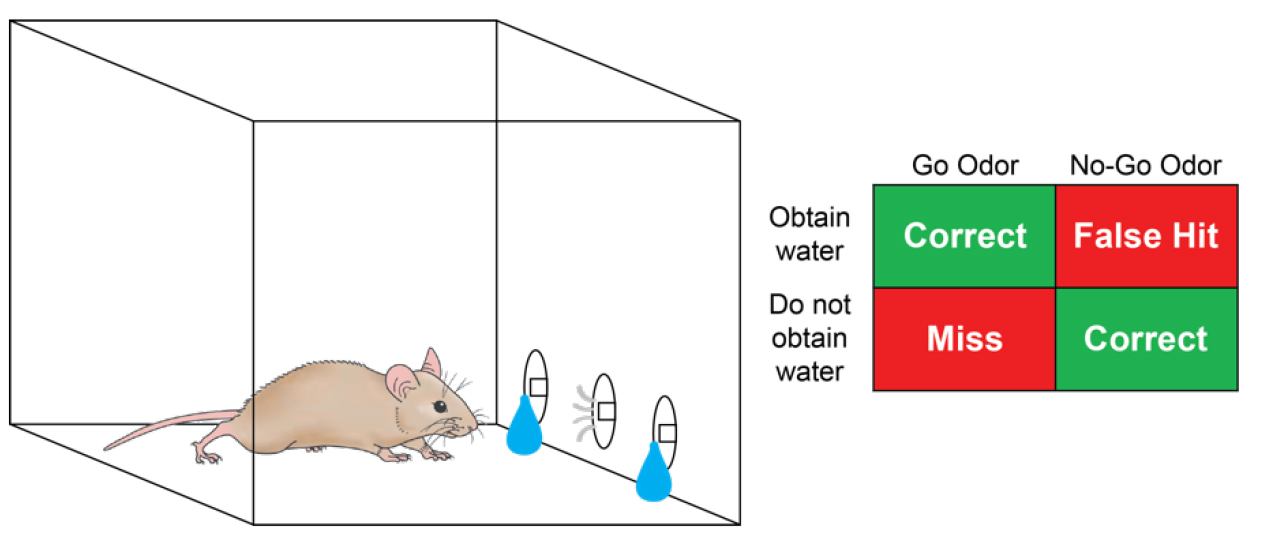
Figure 1. Go/No-Go task. Trained, water-deprived mice will first poke their nose into the central odor port to initiate odor delivery. Subsequently, either a Go or No-Go odor is delivered at random. If the Go Odor is delivered, trained mice will move to either of the two side ports to collect the water reward. If the No-Go odor is delivered, trained mice will refrain from seeking water and re-poke into the odor port.
Materials and Reagents
- Distinct pair of odorants selected by experimenter to represent the ‘Go’ or S+ stimulus and ‘No-Go’ or S- stimulus. Example: 1-butanol and propionic acid (Sigma-Aldrich, catalog numbers: 437603 and 402907 , respectively)–diluted to 10% in mineral oil (Alfa Aesar, catalog number: 31911 ) (500 µl odorant in 5 ml of mineral oil)
- Qorpak borosilicate glass vial with Green Polypropylene Hole Cap (Qorpak, catalog number: GLC-01016 )
- Nalgene silicone tubing (Thermo Fisher Scientific, Thermo ScientificTM, catalog number: 8600-0030 )
- BD PrecisionGlideTM 18 gauge beveled needles (BD, catalog number: 305196 )
- Adult mice (> 6 weeks old, our lab uses on average 12 to 19 weeks old mice with average body weights of 19 g for females and 23 g for males)
Equipment
- Extra Wide Modular Test Chamber-Mouse (Med Associates, catalog number: ENV-307W )
- Stainless Steel Grid Floor (Med Associates, catalog number: ENV-307W-GFW )
- Illuminated Nose Poke Response for Wide Mouse Modular Chamber (Med Associates, catalog number: ENV-313W ) (x2)
- Two Channel Olfactory Stimulus (Med Associates, catalog number: ENV-275 )
- Illuminated Nose Poke Response with Olfactory Ports for Mouse (Med Associates, catalog number: ENV-375W-NPP )
- Stand Alone USB Interface, 4 In/8 out Compatible with 32bit OS only (Med Associates, catalog number: DIG-703A-USB )
- Standard desktop computer with Windows 2000, XP, Vista, or 7 operating system
- VWR flow meter, Acrylic (VWR, catalog number: 97004-952 )
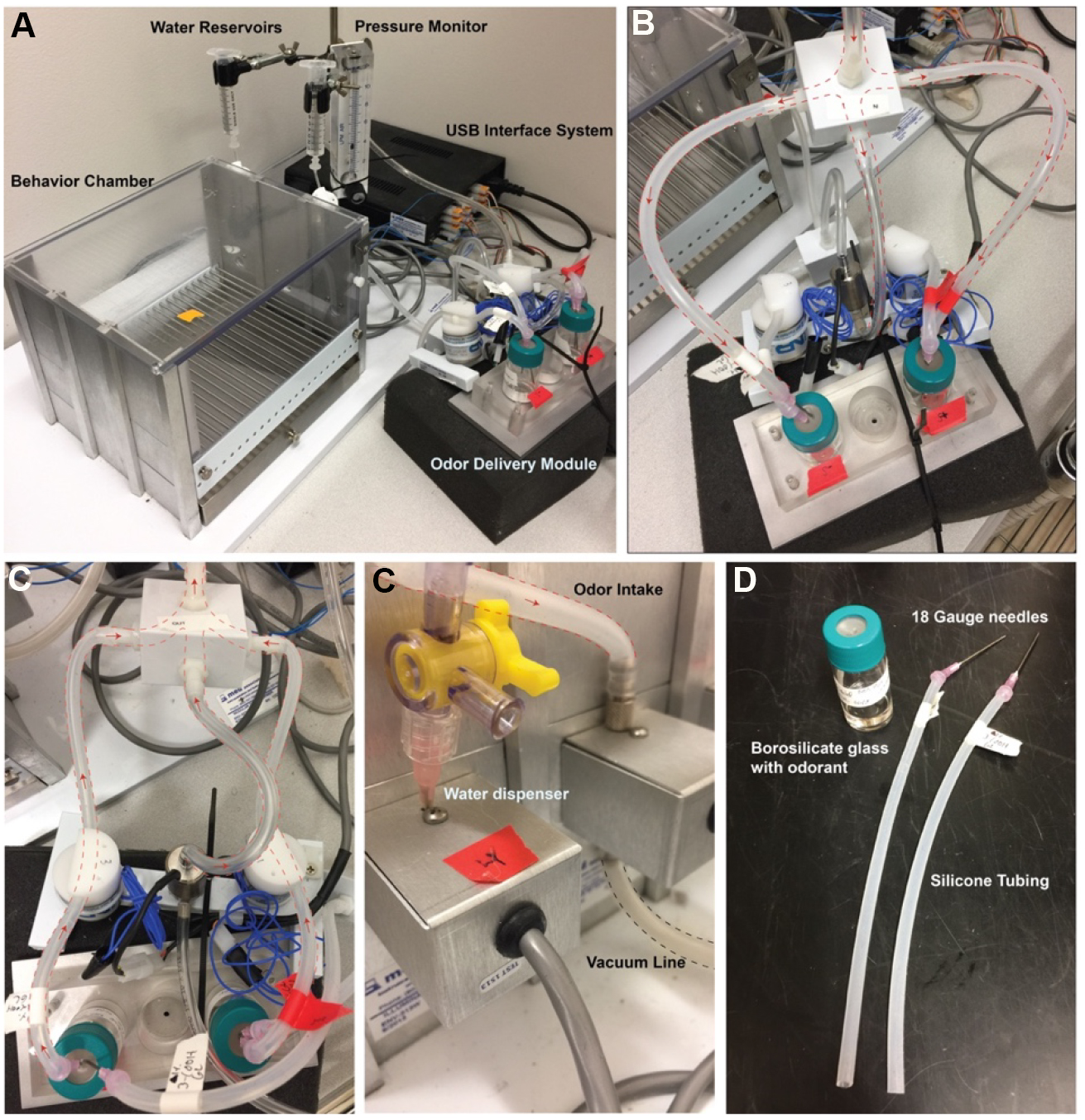
Figure 2. Go/No-Go equipment. The behavior system contains 6 key components: Behavior chamber, water reservoirs, air adjustment, USB interface system, odor delivery module, and a personalized computer (A). Room air is first relayed from the air adjustment to the input air manifold and subsequently diverged to the two odor-containing glass vials and the center valve (B). Odorized air outputs are controlled by two solenoids (C), which can be programmed by the Schedule Manager software. An odor intake line, a vacuum line, and two water dispensers are connected to the behavior chamber (D). Each odor vial is paired with its own two silicone tubes fitted with 18 gauge needles to prevent contamination of odors (E).
Software
- MED-PC IV behavioral software suite (Med Associates, SOF-735)
Note: This version of the software has now been replaced with Med-PC V. - MPC2XL-Data Transfer Utility for all MED-PC Users (Med Associates, SOF-731), required for data reformatting to Excel
- Schedule Manager Software (Med Associates, catalog number: DIG-703A-USB), required for programming training stages
Procedure
文章信息
版权信息
© 2017 The Authors; exclusive licensee Bio-protocol LLC.
如何引用
Readers should cite both the Bio-protocol article and the original research article where this protocol was used:
- Liu, G., McClard, C., Tepe, B., Swanson, J., Pekarek, B., Panneerselvam, S. and Arenkiel, B. R. (2017). Olfactory Cued Learning Paradigm. Bio-protocol 7(9): e2251. DOI: 10.21769/BioProtoc.2251.
-
Huang, L., Ung, K., Garcia, I., Quast, K. B., Cordiner, K., Saggau, P. and Arenkiel, B. R. (2016). Task learning promotes plasticity of interneuron connectivity maps in the olfactory bulb. J Neurosci 36(34): 8856-8871.
分类
神经科学 > 行为神经科学 > 学习和记忆
您对这篇实验方法有问题吗?
在此处发布您的问题,我们将邀请本文作者来回答。同时,我们会将您的问题发布到Bio-protocol Exchange,以便寻求社区成员的帮助。
Share
Bluesky
X
Copy link






